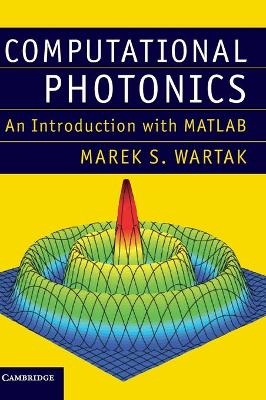
Computational Photonics
An Introduction with MATLAB
Seiten
2013
Cambridge University Press (Verlag)
978-1-107-00552-5 (ISBN)
Cambridge University Press (Verlag)
978-1-107-00552-5 (ISBN)
A comprehensive manual on the efficient modeling and analysis of photonic devices through building numerical codes, this book provides graduate students and researchers with the theoretical background and MATLAB programs necessary for them to start their own numerical experiments. It is ideal for engineers, physicists and practising scientists.
A comprehensive manual on the efficient modeling and analysis of photonic devices through building numerical codes, this book provides graduate students and researchers with the theoretical background and MATLAB programs necessary for them to start their own numerical experiments. Beginning by summarizing topics in optics and electromagnetism, the book discusses optical planar waveguides, linear optical fiber, the propagation of linear pulses, laser diodes, optical amplifiers, optical receivers, finite-difference time-domain method, beam propagation method and some wavelength division devices, solitons, solar cells and metamaterials. Assuming only a basic knowledge of physics and numerical methods, the book is ideal for engineers, physicists and practising scientists. It concentrates on the operating principles of optical devices, as well as the models and numerical methods used to describe them.
A comprehensive manual on the efficient modeling and analysis of photonic devices through building numerical codes, this book provides graduate students and researchers with the theoretical background and MATLAB programs necessary for them to start their own numerical experiments. Beginning by summarizing topics in optics and electromagnetism, the book discusses optical planar waveguides, linear optical fiber, the propagation of linear pulses, laser diodes, optical amplifiers, optical receivers, finite-difference time-domain method, beam propagation method and some wavelength division devices, solitons, solar cells and metamaterials. Assuming only a basic knowledge of physics and numerical methods, the book is ideal for engineers, physicists and practising scientists. It concentrates on the operating principles of optical devices, as well as the models and numerical methods used to describe them.
Marek S. Wartak is a Professor in the Department of Physics and Computer Science, Wilfrid Laurier University, Waterloo, Ontario. He has over 25 years of experience in semiconductor physics, photonics and optoelectronics, analytical methods, modeling and computer-aided design tools.
1. Introduction; 2. Basic facts from optics; 3. Basic facts from electromagnetism; 4. Slab waveguides; 5. Linear optical fibre and signal degradation; 6. Propagation of linear pulses; 7. Optical sources; 8. Optical amplifiers and EDFA; 9. Semiconductor optical amplifiers (SOA); 10. Optical receivers; 11. Finite difference time domain (FDTD) formulation; 12. Solar cells; 13. Metamaterials; Appendices; Index.
| Erscheint lt. Verlag | 10.1.2013 |
|---|---|
| Zusatzinfo | Worked examples or Exercises; 5 Halftones, unspecified; 235 Line drawings, unspecified |
| Verlagsort | Cambridge |
| Sprache | englisch |
| Maße | 193 x 252 mm |
| Gewicht | 1150 g |
| Themenwelt | Mathematik / Informatik ► Mathematik ► Computerprogramme / Computeralgebra |
| Naturwissenschaften ► Physik / Astronomie ► Optik | |
| Technik | |
| ISBN-10 | 1-107-00552-3 / 1107005523 |
| ISBN-13 | 978-1-107-00552-5 / 9781107005525 |
| Zustand | Neuware |
| Haben Sie eine Frage zum Produkt? |
Mehr entdecken
aus dem Bereich
aus dem Bereich
Buch | Softcover (2024)
SAGE Publications Inc (Verlag)
CHF 99,95
An Introduction
Buch | Hardcover (2023)
SAGE Publications Ltd (Verlag)
CHF 199,95


